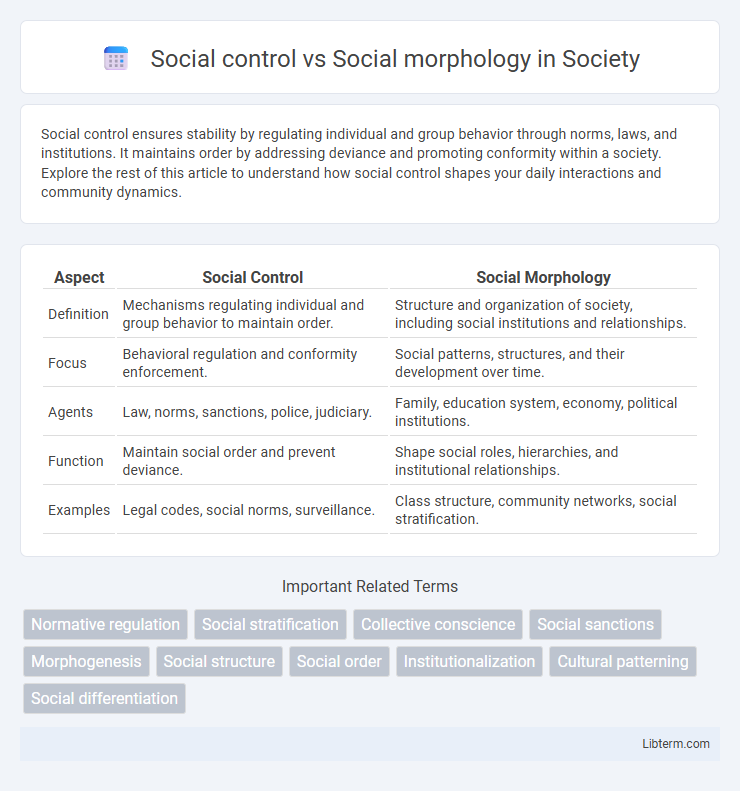Social control ensures stability by regulating individual and group behavior through norms, laws, and institutions. It maintains order by addressing deviance and promoting conformity within a society. Explore the rest of this article to understand how social control shapes your daily interactions and community dynamics.
Table of Comparison
| Aspect | Social Control | Social Morphology |
|---|---|---|
| Definition | Mechanisms regulating individual and group behavior to maintain order. | Structure and organization of society, including social institutions and relationships. |
| Focus | Behavioral regulation and conformity enforcement. | Social patterns, structures, and their development over time. |
| Agents | Law, norms, sanctions, police, judiciary. | Family, education system, economy, political institutions. |
| Function | Maintain social order and prevent deviance. | Shape social roles, hierarchies, and institutional relationships. |
| Examples | Legal codes, social norms, surveillance. | Class structure, community networks, social stratification. |
Introduction to Social Control and Social Morphology
Social control refers to the mechanisms, strategies, and institutions society uses to regulate individual behavior and maintain social order, including laws, norms, and sanctions. Social morphology examines the structure and organization of societies, focusing on the spatial and demographic patterns that influence social interactions and relationships. Together, these concepts provide a framework for understanding how societal order is maintained and how social structures shape human behavior.
Defining Social Control: Mechanisms and Functions
Social control encompasses the mechanisms, strategies, and institutions that regulate individual and group behavior to maintain order and conformity within society. These functions include enforcing norms, deterring deviance, and facilitating social integration through formal laws, informal social norms, and sanctions. Understanding social control highlights its role in sustaining social stability and preventing chaos by aligning personal actions with collective expectations.
Understanding Social Morphology: Structure and Patterns
Social morphology examines the structure and patterns of society by analyzing the organization of social groups, institutions, and networks. It focuses on spatial distribution, population size, density, and heterogeneity to explain social dynamics and changes. Understanding social morphology provides insights into how societal structures influence social control mechanisms and collective behavior.
Historical Perspectives on Social Control and Morphology
Historical perspectives on social control emphasize mechanisms like laws, norms, and institutions that regulate individual behavior to maintain social order, tracing back to theorists such as Emile Durkheim and Michel Foucault. Social morphology, originating from Auguste Comte and later developed by Ferdinand Tonnies, analyzes the structural components of society, including population size, density, and heterogeneity that shape social dynamics. Understanding the interplay between social control and morphology reveals how the physical and social organization of communities influences regulatory practices and collective behavior over time.
Key Differences Between Social Control and Social Morphology
Social control refers to mechanisms, strategies, and institutions that regulate individual and group behavior to maintain order and conformity within society, emphasizing norms, laws, and sanctions. Social morphology focuses on the structural aspects of society, including the organization, distribution, and relationships of social groups and institutions, highlighting patterns such as social stratification, population density, and social networks. The key difference lies in social control's focus on behavioral regulation and conformity, while social morphology analyzes the structural characteristics and organization of society.
Intersection of Social Control and Social Morphology
The intersection of social control and social morphology reveals how societal structures influence mechanisms of regulation and conformity within groups. Social morphology examines patterns of social relationships and organization, while social control focuses on the enforcement of norms and laws to maintain order. Understanding their interplay highlights the role of social networks and institutional frameworks in shaping both behavior and social cohesion.
The Role of Social Institutions in Social Control
Social control relies heavily on social institutions such as family, education, religion, and law enforcement to regulate individual behavior and maintain societal order. These institutions establish norms, enforce rules, and provide mechanisms for sanctioning deviance, ensuring conformity within social groups. Social morphology, which examines the structural organization and relationships within societies, provides the framework within which these institutions operate to exert social control effectively.
The Impact of Social Morphology on Group Dynamics
Social morphology, encompassing population size, density, and heterogeneity, profoundly shapes group dynamics by influencing interaction patterns, social roles, and cohesion within communities. Variations in social morphology affect how social control mechanisms function, as larger or more diverse groups often require formalized norms and institutions to maintain order efficiently. Understanding the impact of social morphology facilitates insights into how structural factors contribute to collective behavior and social organization.
Contemporary Examples of Social Control vs Social Morphology
Social control in contemporary society is exemplified by surveillance technologies such as facial recognition systems used in public spaces to enforce laws and norms, ensuring conformity through monitoring and regulation. Social morphology today is observed in urban demographics, where changes in population density, age distribution, and spatial organization influence social interactions and community structures, such as the gentrification of neighborhoods reshaping social networks. The interplay of social control mechanisms and social morphology can be seen in smart cities, where data-driven governance shapes social behavior while urban form adapts to technological and demographic shifts.
Conclusion: Integrating Insights for Social Analysis
Social control and social morphology both provide critical frameworks for understanding societal structures and behaviors by examining regulatory mechanisms and the organization of social groups, respectively. Integrating insights from social control's focus on norms, laws, and sanctions with social morphology's emphasis on social composition, spatial distribution, and institutional patterns enhances comprehensive social analysis. This synthesis enables a multidimensional approach to studying the dynamic interactions between social order and structural configurations in complex societies.
Social control Infographic

 libterm.com
libterm.com